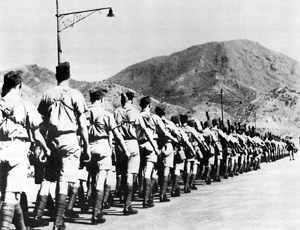Combat uniform
Combat uniform refers to the standard military uniform that members of the armed forces wear during combat operations. Designed for durability, protection, and camouflage, combat uniforms have evolved significantly over time to incorporate advanced materials and technology. They are distinct from dress uniforms, which are worn during ceremonial occasions.
History[edit | edit source]
The concept of a combat uniform dates back to ancient civilizations, where soldiers wore specific attire to distinguish themselves from the enemy. However, the modern combat uniform began to take shape in the 19th century, with the introduction of uniforms designed for specific military functions and environments. The 20th century saw rapid advancements in materials and camouflage techniques, influenced by the two World Wars and subsequent conflicts.
Components[edit | edit source]
A typical combat uniform consists of several components, each designed for functionality and protection on the battlefield.
Jacket and Trousers[edit | edit source]
The jacket and trousers are usually made of durable, rip-stop fabric, with patterns or colors selected for camouflage in specific environments, such as woodland, desert, or urban areas.
Headgear[edit | edit source]
Headgear varies by country and mission, including items such as helmets for protection and boonie hats or patrol caps for camouflage and sun protection.
Footwear[edit | edit source]
Military boots are designed for durability and to protect the feet in various terrains, from desert sands to jungle floors.
Load-Carrying Equipment[edit | edit source]
This includes vests, belts, and harnesses designed to carry ammunition, water, and other essential gear.
Body Armor[edit | edit source]
Modern combat uniforms may be worn with body armor to protect against ballistic threats.
Camouflage[edit | edit source]
Camouflage is a critical aspect of the combat uniform, designed to conceal soldiers from the enemy. Patterns and colors are chosen based on the operational environment, and there has been a trend towards digital camouflage patterns, which are designed to be more effective across a variety of environments.
Technological Advancements[edit | edit source]
Recent advancements in combat uniform technology include the integration of nanotechnology for improved durability and protection, moisture-wicking fabrics to keep soldiers dry, and even uniforms capable of monitoring a soldier's health status.
Global Variations[edit | edit source]
There is significant variation in combat uniforms globally, with each country developing patterns and designs suited to their environment and tactical needs. Some countries have multiple patterns for different environments, while others have a single, multi-environment pattern.
Future Trends[edit | edit source]
The future of combat uniforms includes the development of smart fabrics capable of adapting to environmental changes, providing camouflage, or even generating power for electronic devices.
Navigation: Wellness - Encyclopedia - Health topics - Disease Index - Drugs - World Directory - Gray's Anatomy - Keto diet - Recipes
Search WikiMD
Ad.Tired of being Overweight? Try W8MD's physician weight loss program.
Semaglutide (Ozempic / Wegovy and Tirzepatide (Mounjaro / Zepbound) available.
Advertise on WikiMD
WikiMD is not a substitute for professional medical advice. See full disclaimer.
Credits:Most images are courtesy of Wikimedia commons, and templates Wikipedia, licensed under CC BY SA or similar.Contributors: Prab R. Tumpati, MD




